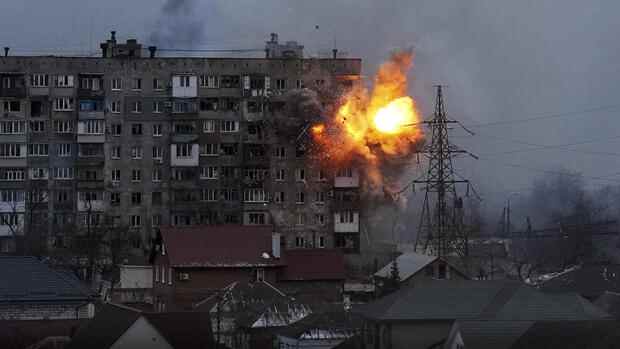Berlin A video has been circulating on social media of a T-34 tank getting onto a flatbed truck, sliding and lying on its side: “World War II tank plays dead to avoid being sent to Ukraine,” someone wrote commented on the film. The video is intended to ridicule the Russian army, which is not yet using World War II equipment in Ukraine, but is using 50-year-old T-62 tanks.
But even if, according to Defense Minister Oleksiy Resnikov, the Ukrainian army is now preparing a counter-offensive to recapture the occupied areas in the south of the country, military experts do not see a quick end to the violence in sight. “The war of attrition continues,” says Gustav Gressel of the European Council on Foreign Relations (ECFR).
The Russian army is making small gains in territory in the east thanks to its superior firepower. However, the lack of infantry made itself felt again and again. In the battle for the small town of Popasna in the Luhansk district, many Ukrainian soldiers escaped encirclement because the Russians were unable to close the ring.
As military analysts have evaluated from publicly available information, Russia has now suffered up to 35,000 casualties. Counting the wounded, at least 100,000 Russian soldiers may have been disabled. Meanwhile, the toll of blood on the Ukrainian side has also increased. “It should be similar to that of the Russians,” says one analyst.
Top jobs of the day
Find the best jobs now and
be notified by email.
>> Also read here: Nato-Expert Babst: “I would not underestimate Russia’s military capabilities”
The British Ministry of Defense reported last week that it was expecting a redeployment of Russian troops after the extensive conquest of the Luhansk region. After that, new offensive operations could start in the Donetsk region. According to pro-Russian separatists, Russian troops tried to encircle the city of Siewersk in the region on Tuesday.
According to security experts, Ukraine, on the other hand, is likely to aim to recapture the city of Cherson, which lies at the mouth of the Dnieper in the Black Sea. This would demonstrate offensive strength and make Russian advances into the big city of Odessa more difficult. Above all, Kyiv is likely to want to prevent Russia from cutting off the Ukraine from the sea.
In order not to endanger human lives unnecessarily during the announced counter-offensive, Deputy Prime Minister Irina Wereshchuk called on civilians in the south of the country to get to safety. However, security experts have doubts as to whether the Ukrainian army is really capable of a major offensive.
According to a rule of thumb, this would require a numerical superiority of three to one in the contested areas. Also, an offensive would have to begin soon and be completed before winter, because then the weather would make the fight more difficult.
The heavy weapons from the West do bring benefits to Ukraine. This applies, for example, to the Panzerhaubitzen 2000 supplied by Germany and the Netherlands and even more so to the HIMARS rocket launchers from the USA, says ECFR expert Gressel.
>> Also read here: Ten Weeks in the “Meat Grinder”: A Reconstruction of the Battle of Luhansk
Previously, Ukraine’s main heavy artillery missile system was the BM-27 Urgan, for which there were also precision GPS-guided ammunition manufactured in the country. However, the ammunition companies have now been attacked and largely destroyed. In addition, the Russians had relocated munitions, staff or field workshops 40 to 50 kilometers behind the front, outside the range of the BM-27.
Thanks to the HIMARS rocket launchers with a range of 80 kilometers, more remote targets such as ammunition depots can now also be reached. This could slow the Russian offensive, which relies on the plentiful availability of ammunition, says Gressel. However, it is to be expected that the Russian armed forces will now move larger depots further away.
Ukraine needs more weapons and ammunition
And the problem of quantity remains: “There are very, very many targets on a 1,200-kilometer front line,” says Gressel. Germany and the Netherlands have so far delivered twelve Panzerhaubitz 2000, the Americans eight HIMARS systems, four more are promised. Germany also wants to sell three more Panzerhaubitz 2000 and three multiple rocket launchers “Mars” from Bundeswehr stocks. On Tuesday, Federal Defense Minister Christine Lambrecht (SPD) held a video conference with her Ukrainian colleague Resnikov to coordinate further support.
The western systems can help to fight particularly valuable enemy targets, emphasizes Gressel. “But there are too few for day-to-day fire support in combined arms combat.” Ukraine also continues to lack ammunition supplies, with production capacities slowly being ramped up in Poland, the Czech Republic and Slovakia. Further production lines will soon be opened in Romania and Bulgaria. “Then,” says Gressel, “hopefully things will get better.”
More: Reconstructing a state failure: How Germany ran into Putin’s energy trap
